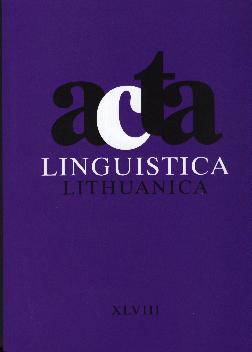Lietuvių kalbos nekirčiuotų balsių kiekybė
The quantity of unstressed vowels in Standard Lithuanian
Author(s): Lidija KaukėnienėSubject(s): Language and Literature Studies
Published by: Lietuvių Kalbos Institutas
Keywords: Lithuanian; vowel
Summary/Abstract: This paper presents the result of an investigation into the quantity of unstressed vowels in Standard Lithuanian, using instrumental and statistic methods. The results show that the quantity of unstressed vowels in Lithuanian is not the same as that of stressed ones: the former undergo reduction. Long vowels are longest under stress, somewhat shorter in post-tonal position and shortest in pre-tonal position. In second pre-tonal position al long vowel is 2,5 times shorter than under stress, in first pre-tonal position 2,1 times, in first and second post-tonal position 1,6 times. Short unstressed vowels are not reduced as much as long ones. In second pre-tonal position a short vowel is 1,2 times shorter than under stress, in first pre-tonal and first post-tonalposition 1,1 times shorter. The second post-tonal vowel is not reduced. The ration between stressed vowels and vowels in second post-tonal position is 1 : 1, which means that in the latter position longer endings possibly receive non-phonological secondary stress. Pre-tonal long and short vowels are shorter than post-tonal vowels in the same positions. The second long pre-tonal vowel is shorter than the first one, and the second short post-tonal vowel is longer than the first one. The quantity of long ans short vowels was also compared in both stressed and unstressed position. Short stressed vowels are 2,3 times shorter than long stressed ones, whereas pre-tonal long vowels are only 1,1 times longer than short ones in the same positions. This means that in the positions under consideration the quantity of long unstressed vowels does not differ from that of short ones. Post-tonal long vowels are 1,5 times longer than short ones. In these positions, quantitative reduction is less marked.
Journal: Acta Linguistica Lithuanica
- Issue Year: 2003
- Issue No: 48
- Page Range: 35-47
- Page Count: 12
- Language: Lithuanian

